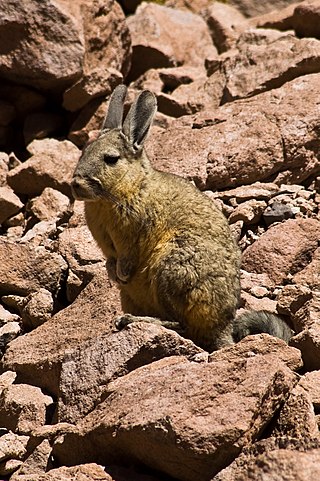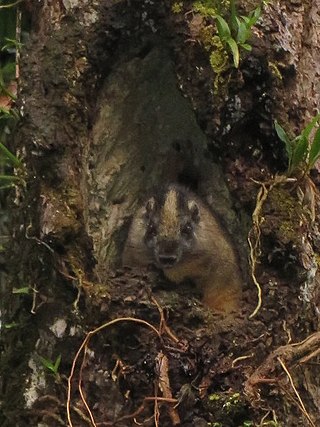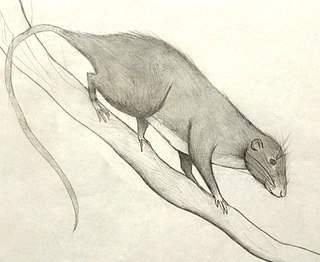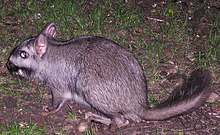
The family Chinchillidae is in the order Rodentia and consists of the chinchillas, the viscachas, and their fossil relatives. This family is restricted to southern and western South America, mostly living in mountainous regions of the Andes but one species living on plains. They are medium to large-sized rodents, weighing from 800 g (28 oz) to 8 kg (18 lb), with strong hind legs and large ears and a bushy tail. All species have thick, soft fur, which is considered valuable in some cultures.

Viscacha or vizcacha are rodents of two genera in the family Chinchillidae. They are native to South America and convergently resemble rabbits.

The toros or brush-tailed rats, genus Isothrix, are a group of spiny rats found in tropical South America, particularly in the Amazon Basin.
The tuft-tailed spiny tree rat is a spiny rat species from Brazil south of the Amazon River, where it has been found in grassland and gallery forest. It is the only species in the genus Lonchothrix. Very little is known about this rodent. It is small with an average adult weight of about 138 grams. It is nocturnal and solitary in habits.

Simons's spiny rat is a spiny rat species found in Bolivia, Brazil, Colombia, Ecuador and Peru. It was named for American scientific collector Perry O. Simons.

Proechimys is a genus of South American spiny rats of the family Echimyidae. All species of the genus are terrestrial. In the lowland Neotropical forests, Proechimys rodents are often the most abundant non-volant mammals. They are recognizable by reason of their elongated heads and long rostra, large and erect ears, narrow and long hind feet, and tails always shorter than head-and-body lengths. The dorsal pelage comprises a mixture of expanded, varyingly stiffened spines — hence the vernacular name of spiny rats — and soft hairs.

Mesomys is a genus of South American spiny rats in the family Echimyidae.

Dactylomys is the genus of South American bamboo rats They are arboreal members of the family Echimyidae.

Olallamys is a genus of Andean soft-furred spiny rat that range from Panama through Colombia and Venezuela to northern Ecuador. These species are typically found at elevations above 2,000 metres (6,600 ft).

Diplomys is a genus of rodent in the family Echimyidae. They are found in Costa Rica, Ecuador, Colombia and Panama.

The plains viscacha or plains vizcacha is a species of viscacha, a rodent in the family Chinchillidae. It is the only living species within the genus Lagostomus. It is found in Argentina, Bolivia, and Paraguay. The plains viscacha is the largest species in its family. They construct elaborate burrows that house successive colonies for decades.
The Colombian spiny-rat is a species of rodent in the family Echimyidae. It is found in Colombia and Venezuela.
The Pacific spiny rat is a species of rodent in the family Echimyidae. It is found in Ecuador and Peru.
The Guaira spiny-rat is a species of rodent in the family Echimyidae. It is endemic to Venezuela. It is commonly referred to as 'casiragua' to avoid confusion with true rats (Muroidea)
The Minca spiny rat is a species of rodent in the family Echimyidae. It is endemic to Colombia.
O'Connell's spiny-rat is a species of rodent in the family Echimyidae. It is endemic to Colombia.
Lagostomus crassus is an extinct species of viscacha that was native to Peru. It is known from a single skull found in southern Peru.
Pattonomys is a genus of rodent in the family Echimyidae, named after American mammalogist James L. Patton. It contains the following species:

Lagidium ahuacaense is a rodent in the mountain viscacha genus (Lagidium) that occurs in southern Ecuador. First observed in 2005 and formally described in 2009, it occurs more than 500 km (310 mi) north of the nearest previously known population of mountain viscachas in central Peru. Only a single population is known, found on rocky habitats on Cerro El Ahuaca, an isolated granite mountain in southern Ecuador, and as few as several dozen individuals remain. The species is threatened by fires and grazing cattle, and the discoverers recommended its conservation status be assessed as critically endangered.

Echimyini is a tribe of echimyid rodents, proposed in 2016, and containing 13 extant genera: all of the tree rats Echimys, Phyllomys, Makalata, Pattonomys, Toromys, Diplomys, Santamartamys, and Isothrix, the long recognized dactylomines Dactylomys, Olallamys, and Kannabateomys, and the enigmatic and previously classified as eumysopines Lonchothrix and Mesomys. All these spiny rats genera are arboreal. Worth of note, the arboreal genus Callistomys – the painted-tree rat – does not belong to the tribe Echimyini. Because it is phylogenetically closer to Myocastor, Hoplomys, Proechimys, and Thrichomys than to the above-mentioned Echimyini genera, it is classified in the tribe Myocastorini.











